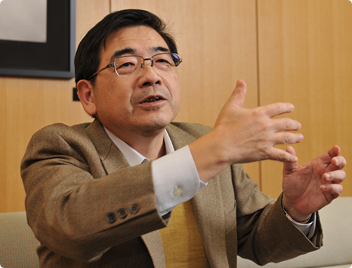Researchers need to invent their own particular subject of study.
Hints from the human body.

You have young researchers working in your laboratory. What do you expect of them? What are the talents required by a researcher?
Researchers are required to invent a unique subject, one of their own. Students are assigned subjects of study while they are still undergraduates. Before college, most of them might never have had a chance to choose their own. Once they create their own subject, what follows will be easier. They will have already discovered solutions for the essential half of their chosen line of research.
Inventing the subject of study? Do you mean researchers themselves must find their own subject?
Yes. A researcher needs to plan a subject of study determining what’s important for it. Personally, I was initially given a subject of study by my section manager when I first joined the company. But later, I started finding it by myself. Researchers in my laboratory are requested to invent their own subjects considering the long-term perspective. Personal subjects are not the kind of study one is instructed to take. Finding them by oneself is the biggest task for our researchers.
What subject of study are you focusing on in your laboratory at the moment?
Our laboratory is currently researching more advanced technologies that will enhance the autofocus and automatic exposure performance of digital cameras, and also working to further improve digital processing technology. At the moment, my greatest interests relate to the study of the functions of the brain and eyes, which are very similar to cameras. For me, the human body is one of the most fascinating subjects of study and what I learn from it will help me develop the next-generation camera.
What similarities, for example?
Human eyes have lenses. The retinas of human eyes correspond to image sensors in cameras. Brains are like cameras’ software that manages image processing. Retinas are composed of a large quantity of cells, arranged into three groups, and that respond to a specific color of either green, red or yellow. Human brain cells resemble the color filters of cameras’ image sensors. Digital cameras sometimes cause false colors or aliasing* when wrong assumptions in computation are made during image processing. With a digital camera, low-pass filters are used to prevent aliasing from being generated. But human eyes do not perceive these false signals, as the brain knows how to compensate for them. The brain selectively deletes aliasing. Human eyes utilize involuntary eye movement, whose function, we may say, resembles that of a low-pass filter in a camera.
So, the human body is full of wonder.
Yes, indeed. We may find something new that would help develop our cameras, if we further delve into the wonders of the human body. Or in turn, we may find further wonders of the human anatomy from our study of photography and its technologies. I happen to have interests about the human body and its functions. This means any researcher can find their particular subject of study almost anywhere. What’s important is to invent the researcher’s own subject of study, focusing on the researcher’s favorite concern.
- *Aliasing: The effect where false colors not existing in the original appear on an image.
